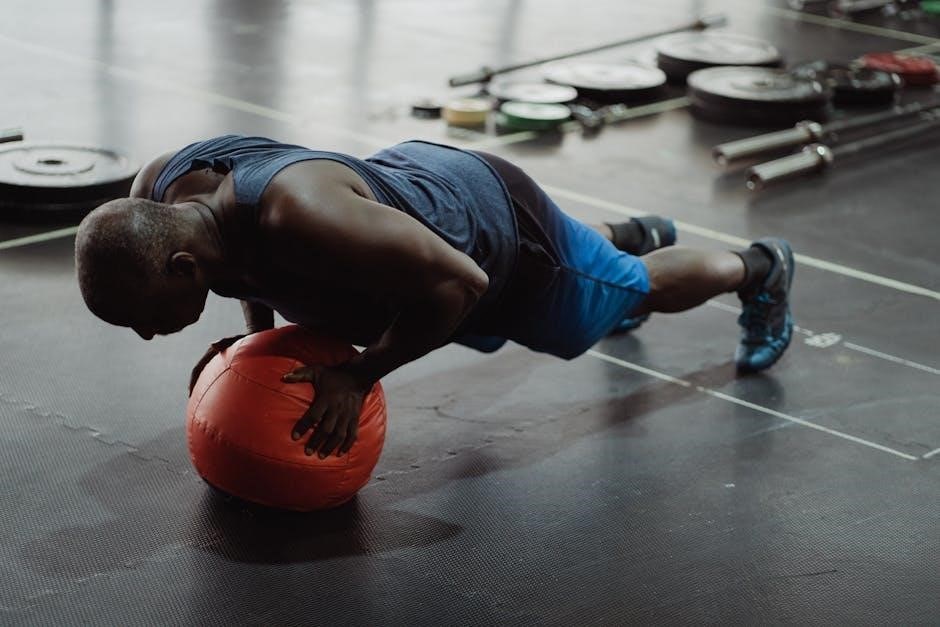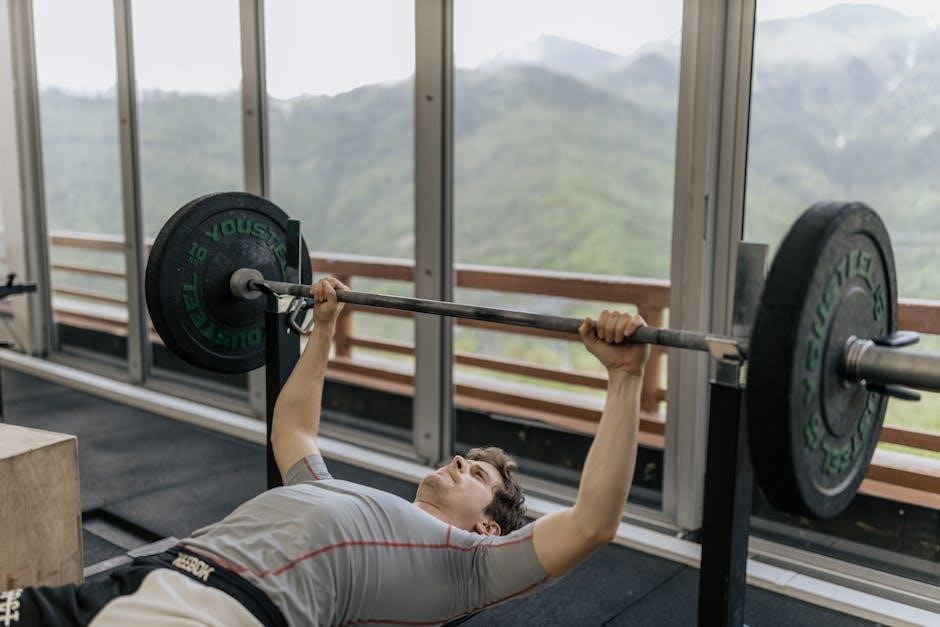
plyometric workout program pdf
Plyometric training involves explosive movements to enhance power and speed. It’s ideal for athletes seeking to improve vertical jump and overall athleticism. PDF guides like David Potach’s “Plyometric and Speed Training” offer structured programs and exercises for effective results.
1.1 What is Plyometric Training?
Plyometric training, or “plyos,” involves explosive movements that generate maximum force in minimal time. It focuses on exercises like jumps, hops, and bounds to enhance power and speed. This method trains muscles to exert force quickly, improving athletic performance. Common exercises include box jumps, depth jumps, and burpees. Plyometrics is widely used in sports to boost vertical jump, acceleration, and overall explosiveness. It’s particularly popular among athletes seeking to enhance their power and agility, making it a cornerstone of many workout programs, including those detailed in PDF guides like David Potach’s “Plyometric and Speed Training.”
1.2 Benefits of Incorporating Plyometrics into Your Workout Routine
Incorporating plyometrics into your workout enhances explosive power, speed, and vertical jump. It improves muscular strength and coordination, benefiting athletes in sports like hockey and basketball. Plyos also boost metabolism and burn calories, making them effective for weight loss. Regular plyometric training increases overall athleticism and agility, while being time-efficient. Many athletes, including hockey players, use plyos to elevate their performance. PDF guides like David Potach’s provide structured routines to maximize these benefits, ensuring safe and effective progression in power and speed training.

Key Concepts of a Plyometric Workout Program
Plyometric workout programs focus on explosive movements, proper form, and structured exercises to enhance power and speed, as detailed in guides like David Potach’s PDF.
2.1 Understanding Explosive Movements and Their Importance
Explosive movements are rapid, powerful actions that generate maximum force in minimal time. These movements are central to plyometric training, enhancing muscle power, speed, and reactivity. They involve quick transitions from eccentric to concentric contractions, optimizing neuromuscular efficiency. Explosive movements improve vertical jump, acceleration, and overall athleticism, making them essential for sports performance. Consistent practice of explosive exercises, such as jump squats or box jumps, strengthens the muscles and enhances coordination, enabling athletes to achieve higher jumps and faster sprints. Mastering these movements is crucial for advancing in plyometric workouts.
2.2 The Role of Vertical Jump in Plyometric Training
Vertical jump is a fundamental component of plyometric training, measuring explosive power and athletic potential. It enhances muscle strength, neuromuscular coordination, and reactivity. Plyometric exercises like box jumps and depth jumps target the lower body, improving the ability to generate force quickly. A higher vertical jump translates to better performance in sports requiring jumping, sprinting, and quick changes of direction. Incorporating vertical jump training into a plyometric program helps athletes achieve greater power and agility, making it a cornerstone of many workout plans aimed at enhancing overall athleticism.

Designing a Plyometric Workout Program
A well-structured plyometric program focuses on phases like movement, coordination, landing, strength, and power. It includes exercises such as box jumps and depth jumps to enhance explosiveness.
3.1 Phases of Plyometric Training: Movement, Coordination, Landing, Strength, and Power
Plyometric training is divided into key phases: movement and coordination, landing techniques, strength development, and power enhancement. Each phase builds on the previous one, ensuring progressive improvement. Starting with basic movements like box jumps, athletes gradually incorporate more complex exercises. Proper landing techniques are emphasized to prevent injuries and maximize efficiency. Strength and power phases focus on explosive movements, such as depth jumps, to enhance overall athleticism. This structured approach ensures a safe and effective progression for all skill levels.
3.2 Structuring a 4-Week Plyometric Program for Vertical Jump Improvement
A 4-week plyometric program for vertical jump improvement typically includes 3 workouts per week. Week 1 focuses on foundational exercises like box jumps and depth jumps. Week 2 introduces explosive movements such as burpees and jump squats. Week 3 incorporates advanced plyos like single-leg hops and lateral bounds. Week 4 emphasizes max effort exercises, including vertical jump tests. Each session begins with a dynamic warm-up and ends with a cool-down to ensure optimal performance and injury prevention. Consistency and progressive overload are key to achieving significant improvements in vertical jump height.
Safety and Form in Plyometric Exercises
Proper form is crucial to prevent injuries. Poor technique can lead to muscle strains or stress fractures. Focus on controlled landings and explosive movements to maximize safety and effectiveness.
4.1 The Importance of Proper Form to Prevent Injuries
Proper form in plyometric exercises is essential to minimize injury risks. Incorrect landings or explosive movements can strain muscles or joints. Emphasizing controlled techniques ensures safe and effective workouts, enhancing performance while reducing harm.
4.2 Warm-Up and Cool-Down Routines for Plyometric Sessions
A proper warm-up and cool-down are crucial for plyometric sessions. Start with dynamic stretches like leg swings and high knees to prepare muscles. Follow with light cardio such as jogging or jumping jacks. Post-workout, static stretches for hamstrings and quads aid flexibility. Foam rolling can reduce muscle tension. A 10-15 minute warm-up and 5-10 minute cool-down ensure optimal performance and injury prevention. Consistency in these routines enhances recovery and maintains athletic readiness for future workouts.

Real-World Applications of Plyometric Training
Plyometric training enhances speed, quickness, and vertical jump, benefiting athletes like hockey players. It’s widely used to improve athleticism and performance in various sports and professional settings.
5.1 How Hockey Players Can Benefit from Plyometric Workouts
Plyometric workouts are highly beneficial for hockey players, enhancing speed, quickness, and vertical jump. Exercises like box jumps and depth jumps improve explosive power, crucial for acceleration on the ice. A structured 4-week program focusing on plyometrics can boost athleticism, making players more dynamic during games. With proper form and consistency, plyos help hockey players achieve faster breaks, sharper turns, and more powerful shots, giving them a competitive edge. Incorporating 2-3 plyometric sessions weekly is recommended for optimal results.
5.2 Enhancing Speed, Quickness, and Athleticism with Plyos
Plyometric exercises are excellent for improving speed, quickness, and overall athleticism. They work by enhancing neuromuscular coordination and power, allowing for faster and more explosive movements. Incorporating plyos into a workout routine can significantly boost acceleration and agility, making them ideal for athletes in various sports. A well-structured plyometric program, as outlined in PDF guides, focuses on exercises like box jumps and burpees to target these areas effectively. Consistency and proper form are key to achieving noticeable improvements in speed and athleticism over time.

Progressive Overload in Plyometric Training
Progressive overload enhances plyometric training by gradually increasing intensity. This approach ensures continuous improvement in power and athleticism, a key aspect of effective plyometric workout programs.
6.1 Increasing Intensity Over Time for Continuous Improvement
Increasing intensity in plyometric training is crucial for continuous improvement. Start with lower box jumps and gradually move to higher platforms as strength and power increase. Over time, introduce more explosive movements like depth jumps or burpee jumps to challenge the body further. Additionally, increase the number of sets or repetitions as athletes adapt. This progressive approach ensures consistent gains in power and athleticism, aligning with the structured plans often outlined in plyometric workout program PDFs for optimal results.

6.2 Adjusting Volume and Frequency for Optimal Results
Adjusting the volume and frequency of plyometric workouts is essential for optimal results. Start with 2-3 sessions per week, focusing on quality over quantity. Gradually increase the number of exercises or sets as the body adapts. Avoid overloading too quickly, as this can lead to injury. Many plyometric workout program PDFs recommend a structured approach, ensuring progressive overload without compromising form or recovery. Consistency and careful planning are key to achieving long-term improvements in power and explosiveness.
Plyometric training is a powerful tool for enhancing athleticism. Use resources like David Potach’s PDF guide to design effective programs. Continue exploring structured plans for sustained progress.

7.1 Summarizing the Key Takeaways of a Plyometric Workout Program
A plyometric workout program focuses on explosive movements to boost power and speed; Proper form, phased training, and progressive overload are crucial for success. Incorporating exercises like box jumps and depth jumps enhances vertical jump and athleticism. A structured 4-week plan, as outlined in guides like David Potach’s PDF, ensures steady progress. Emphasizing quality over quantity and incorporating warm-ups prevents injuries. Consistency and adaptation to individual needs lead to optimal results, making plyometrics a valuable tool for improving performance in sports and fitness.
7.2 Resources for Further Learning and Program Development
For deeper insights, resources like David Potach’s “Plyometric and Speed Training” PDF and ResearchGate offer comprehensive guides. Websites and eBooks provide structured workout plans, exercise tutorials, and expert advice. These materials help tailor programs to individual goals, ensuring safety and effectiveness. They also cover advanced techniques and progression strategies, making them invaluable for coaches and athletes seeking to optimize their plyometric training.
Additional Resources
Explore detailed PDF guides like David Potach’s “Plyometric and Speed Training” and ResearchGate for comprehensive workout plans and exercise tutorials to enhance your plyometric routine effectively.
8.1 Recommended PDF Guides and Research on Plyometric Training
David Potach’s “Plyometric and Speed Training” PDF is a valuable resource, offering detailed workout plans and exercises. ResearchGate provides access to scientific studies and guides on plyometric training. Additionally, resources from the National Academy of Sports Medicine (NASM) and the American Council on Exercise (ACE) include comprehensive plyometric programs. These guides cover topics like vertical jump improvement, explosive power, and injury prevention, making them essential for athletes and coaches seeking structured, evidence-based training methods.
8.2 Finding Reliable Sources for Plyometric Workout Plans
Reliable sources for plyometric workout plans include academic databases like ResearchGate and Google Scholar, which offer peer-reviewed studies and guides. Websites like PDFDrive and Scribd provide access to downloadable PDFs, such as David Potach’s “Plyometric and Speed Training.” Additionally, fitness platforms like National Academy of Sports Medicine (NASM) and American Council on Exercise (ACE) offer evidence-based plyometric programs. These resources ensure you access credible, well-structured plans tailored to improve athleticism, vertical jump, and overall performance safely and effectively.